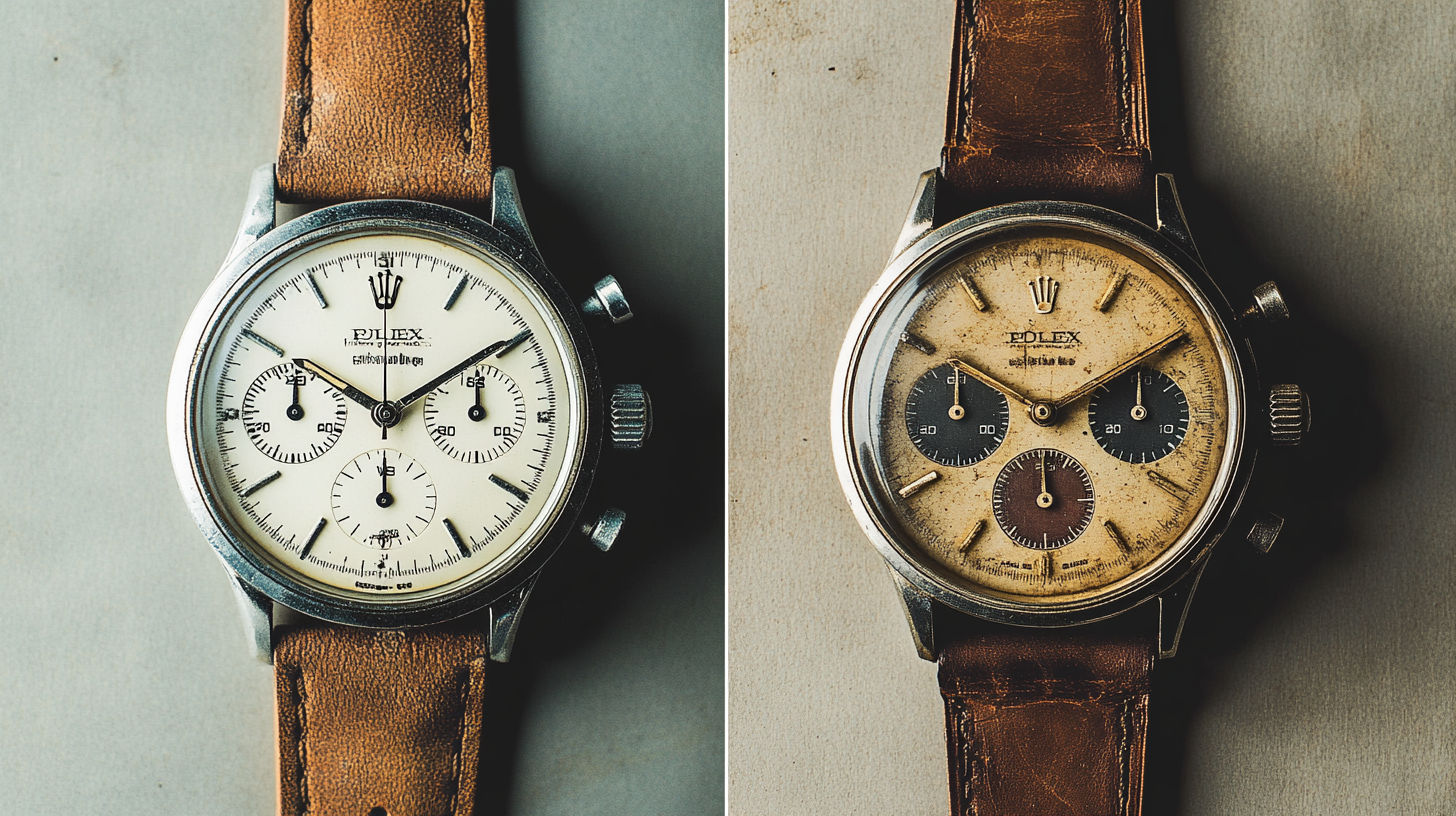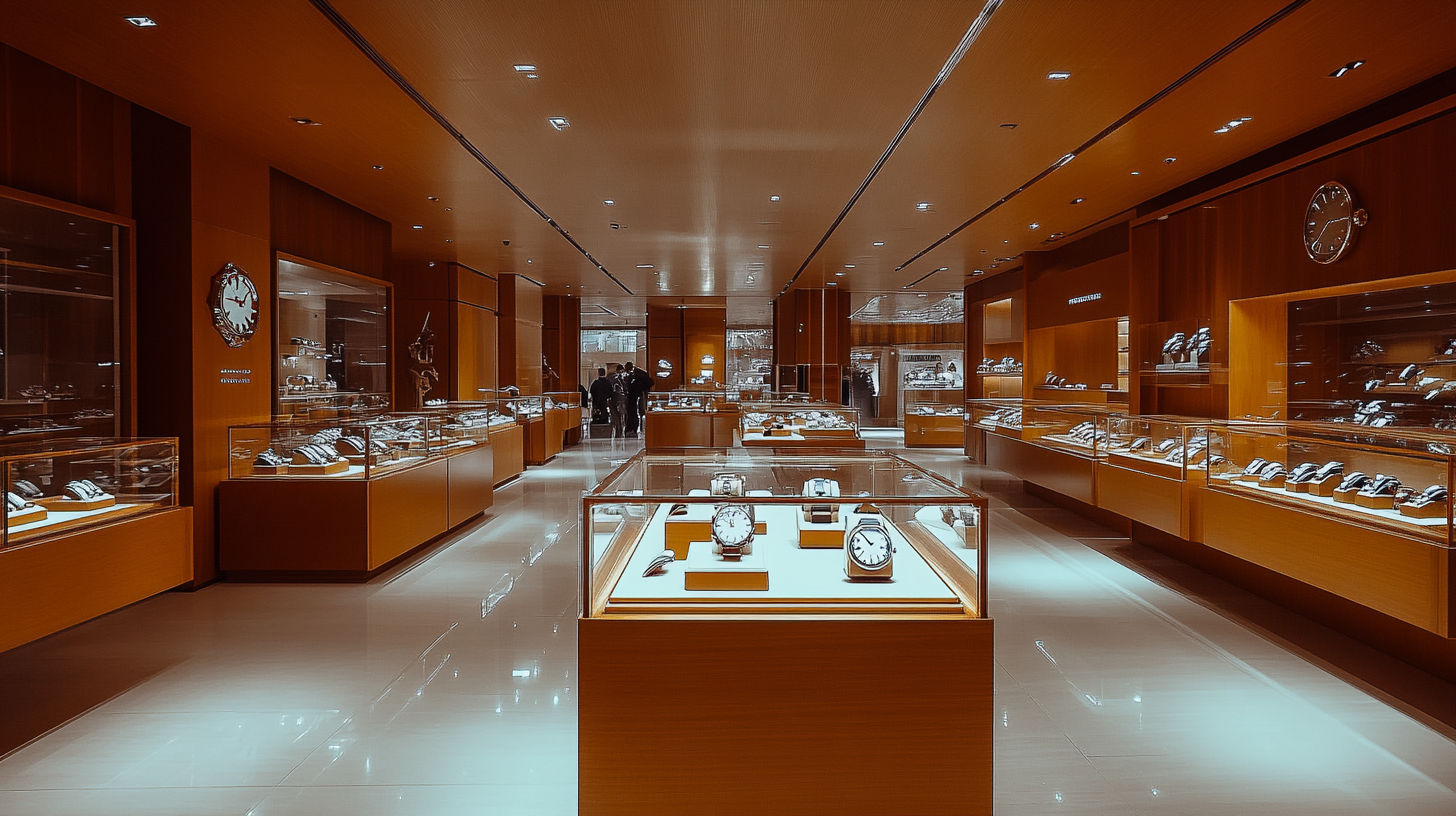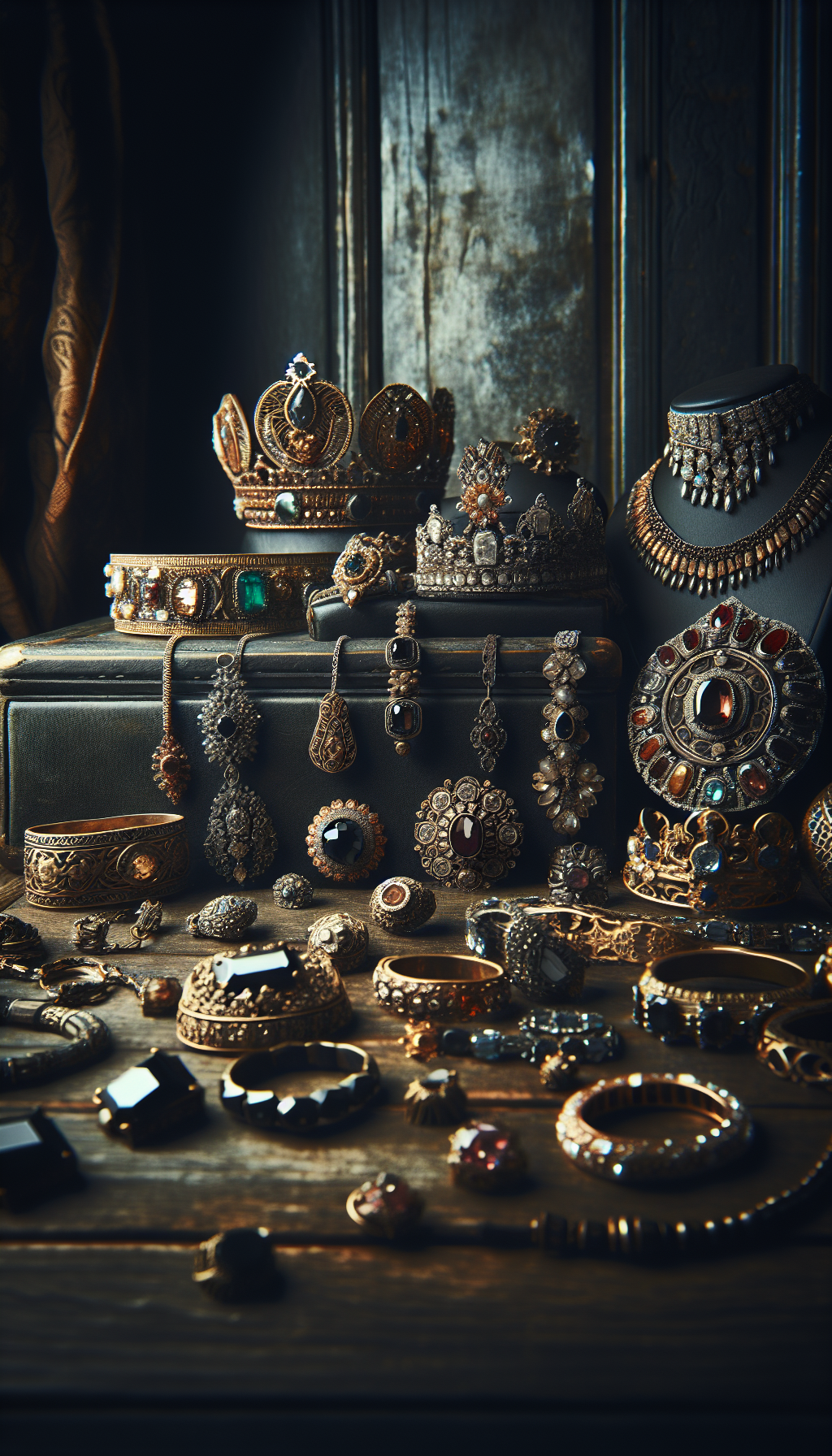Introduction to Vintage Watch Valuation
The market for vintage watches has grown significantly in recent years, with some rare pieces fetching hundreds of thousands or even millions of dollars at auction. However, not all old timepieces are valuable, and numerous factors determine whether your grandfather’s wristwatch is a hidden treasure or merely a sentimental keepsake.
In this comprehensive guide, we’ll explore the key elements that influence vintage watch values, discuss how to research and determine the worth of your timepieces, and provide insights into which brands and models tend to command the highest prices in today’s market.
Vintage Watch Market at a Glance
Key Factors Determining Vintage Watch Value
Brand Prestige and Heritage
The manufacturer’s reputation plays a crucial role in determining value. Luxury Swiss brands like Rolex, Patek Philippe, and Omega consistently command higher prices due to their established heritage, quality craftsmanship, and brand prestige. However, certain models from less renowned manufacturers can also become highly collectible due to unique features or historical significance.
Rarity and Production Numbers
Watches produced in limited quantities naturally tend to be more valuable. Production numbers significantly impact collectibility, with rare variants, limited editions, and discontinued models typically commanding premium prices. A standard production model might be worth considerably less than a rare color variant or special edition of the same watch.
Condition and Originality
The physical state of a vintage watch dramatically affects its value. Collectors generally prefer timepieces in original, unrestored condition with minimal wear. Key condition factors include:
Condition Assessment Factors
Check items that apply to your vintage watch
- Original dial without restoration or repainting
- Case shows minimal polishing or wear
- Original hands, crown, and crystal
- Movement functions correctly and keeps accurate time
- No moisture damage or corrosion inside the case
- Original strap or bracelet in good condition
- Box and papers preserved
Provenance and History
A watch’s history can significantly enhance its value. Timepieces with interesting backgrounds—such as those owned by celebrities, featured in films, or associated with historical events—often fetch premium prices. Documentation proving this provenance becomes extremely important in establishing authenticity and supporting value claims.
Box and Papers
Original packaging, warranty cards, instruction manuals, and purchase receipts can substantially increase a vintage watch’s value—sometimes by 20-30% or more. These items verify authenticity and complete the collecting experience. As watch expert David Silver from The 1916 Company notes, “A complete set with box and papers is the holy grail for serious collectors.”
Market Demand and Trends
Like all collectibles, vintage watch values are influenced by current market trends, collector preferences, and fashion cycles. Models featured in popular media or championed by influential collectors can see rapid price appreciation, while others may fall out of favor.
Most Valuable Vintage Watch Brands
Premium Vintage Watch Brands
Average market value ranges for collectible vintage models in good condition
</tbody>
</table>
According to watch market analysis platform WatchCharts, premium vintage models from prestigious manufacturers have shown consistent value appreciation over time, with some rare examples achieving record-breaking auction results. However, the vintage watch market remains highly nuanced, with specific references, dial variations, and production years commanding vastly different prices even within the same brand.
Evolution of Collectible Watch Brands
- 1839
Patek Philippe Founded
Established in Geneva, Switzerland, Patek Philippe would become one of the most prestigious watchmakers, creating highly collectible timepieces that consistently achieve record auction prices. - 1905
Rolex Founded
Hans Wilsdorf established Rolex, which would grow to become the most recognized luxury watch brand globally, with vintage models like the Submariner and Daytona becoming highly coveted collectibles. - 1957
Omega Speedmaster Introduced
The Omega Speedmaster, later selected by NASA for space missions and moon landings, would become an iconic collectible with early references commanding significant premiums. - 1969
First Automatic Chronograph Movements
The development of automatic chronograph movements by Heuer (now TAG Heuer), Breitling, and others created numerous collectible models that remain sought-after today. - 1970s
Quartz Crisis
The introduction of affordable quartz watches threatened traditional mechanical watchmaking but inadvertently created rarity for mechanical watches from this era, enhancing their collectibility decades later. - 1990s-2000s
Vintage Watch Renaissance
Growing appreciation for mechanical watchmaking craftsmanship sparked increased interest in vintage timepieces, with collectors and investors driving significant market growth.
How to Research Your Vintage Watch's Value

Identify the Brand, Model, and Reference Number
The first step is to properly identify your watch. Look for:
- Brand name on the dial, movement, or case back
- Model name (may not always be visible)
- Reference number usually engraved on the case back or between the lugs (may require removing the bracelet)
- Serial number to help determine production year
As noted in a Reddit discussion, proper identification is crucial since similar-looking watches can have dramatically different values based on specific references or production periods.
Assess Condition Objectively
Be honest about your watch’s condition. According to Dawsons Auctioneers, condition significantly impacts value. Consider:
- Does the watch function properly?
- Is the dial original or refinished?
- Are there signs of water damage or corrosion?
- Has the case been over-polished?
- Are all parts original or have some been replaced?
Utilize Online Valuation Resources
Several online platforms can help determine current market values:
Vintage Watch Valuation Resources
Chrono24 Watch Valuation Tool
Free online tool providing estimated market values based on model and condition, with data from millions of listings.
WatchCharts
Comprehensive platform tracking market data, price trends, and historical sales information for various watch models.
The 1916 Company Valuation Guide
Expert insights into factors affecting watch value and approaches to watch assessment from a reputable dealer.
Auction Results Archives
Historical auction data from major houses like Christie’s, Sotheby’s, and Phillips providing actual realized prices.
Consult with Experts
For particularly valuable or rare pieces, seeking professional opinions is advisable:
- Authorized dealers of the brand can provide insights, though they may not offer formal appraisals
- Watch-specific auction houses like Phillips, Christie’s, or Sotheby’s have specialists who can evaluate valuable timepieces
- Reputable vintage watch dealers often offer evaluation services
- Certified appraisers can provide formal documentation for insurance or sale purposes
Research Completed Sales
Examining recent sales of similar watches provides concrete data about current market values:
- Check completed listings on eBay and other auction platforms
- Review results from watch-specific auctions
- Explore dedicated watch forums where members discuss recent sales
- Use subscription services like WatchCharts Pro that compile sales data
As mentioned in the LoveAntiques guide, understanding recent sales patterns helps you determine fair market value rather than relying on asking prices, which may be inflated.
The Impact of Restoration on Vintage Watch Value
Originality vs. Functionality
According to a discussion on Reddit’s r/VintageWatches, collectors generally value originality. A watch with its original dial, hands, and movement parts—even with some age-appropriate wear—often commands higher prices than one with replacement components or significant restoration work.
However, functionality matters too. A mechanically sound watch with a serviced movement will typically be more valuable than one that doesn’t run properly. The key is finding the right balance between preservation and functionality.
Cost vs. Value Considerations
As noted by myGemma, “A full overhaul of a vintage watch can run from hundreds to thousands of dollars. A high refurbishing cost will lower an item’s second-hand value.”
Before investing in extensive restoration, consider:
- Will the cost of restoration be justified by increased value?
- Is the watch rare enough that restoration makes financial sense?
- Do you plan to keep the watch or sell it?
Best Practices for Maintaining Value
If you own vintage watches or are considering purchases, these guidelines can help preserve value:
Value Preservation Guidelines
Recommendations for maintaining vintage watch value
- Obtain service records when purchasing
- Have movements serviced only by specialists familiar with vintage calibers
- Request that watchmakers preserve original parts
- Avoid polishing cases, which removes material and alters original lines
- Never replace original dials or hands unless absolutely necessary
- Store watches properly to prevent deterioration
- Keep all original boxes, papers, and accessories
Vintage watch expert David Duggan suggests in Dawsons’ article that sympathetic servicing by specialists who understand the importance of preserving originality is crucial for maintaining collectible timepieces.
Investment Potential of Vintage Watches

Historical Performance
According to Watch Obsession, certain vintage watches have shown impressive appreciation over time. For example, early Rolex Submariners and Daytonas, Patek Philippe complicated watches, and some Omega Speedmaster references have multiplied in value several times over the past few decades.
However, performance varies dramatically between brands, models, and even specific references within model lines. As with any investment, past performance doesn’t guarantee future returns.
Key Considerations for Watch Investors
If approaching vintage watches from an investment perspective, consider these factors:
Focus on quality and rarity: Rare, well-preserved examples from prestigious manufacturers typically offer the best long-term appreciation potential.
Research thoroughly: Understanding market trends, production numbers, and historical significance helps identify promising investment pieces.
Condition is paramount: Investment-grade watches should be in excellent original condition with complete documentation when possible.
Take a long-term approach: The vintage watch market can experience short-term fluctuations, but quality pieces tend to appreciate over longer periods.
Factor in additional costs: Insurance, secure storage, and periodic servicing add to the total cost of ownership.
A Reddit discussion about watches that hold value over decades highlights that established brands with historical significance and limited production tend to be safer long-term investments.
Models with Strong Investment History
Based on data from Vintage Gold Watches and auction results, these specific models have demonstrated consistent value appreciation:
Vintage Watches with Strong Investment Track Records
Models with consistent historical value appreciation
| Category | Price | Notes |
|---|---|---|
| Patek Philippe | $5,000 - $1,000,000+ | Highest prestige, exceptional craftsmanship, limited production |
| Rolex | $2,500 - $200,000+ | Strong brand recognition, exceptional durability, iconic designs |
| Audemars Piguet | $4,000 - $150,000+ | Haute horlogerie, complex movements, limited production |
| Vacheron Constantin | $3,500 - $125,000+ | Historical significance, exceptional finishing, prestige |
| Omega | $800 - $60,000+ | Historical importance, Speedmaster "Moonwatch" models particularly valuable |
| Heuer/TAG Heuer | $1,000 - $30,000+ | Vintage chronographs, racing heritage, limited editions |
| Longines | $500 - $15,000+ | Historical significance, high-quality vintage movements |
| Universal Genève | $1,000 - $25,000+ | Historical importance, chronographs, limited production |
</tbody>
</table>
Investment Risks
While some vintage watches have performed exceptionally well as investments, the market carries risks:
- Market fluctuations: Collecting trends can change, affecting demand and prices
- Counterfeits and altered pieces: The market contains sophisticated fakes and watches with non-original parts
- Condition deterioration: Watches require proper care to maintain condition and value
- Liquidity challenges: Finding buyers at fair prices can take time, especially in down markets
- Knowledge barriers: Without expertise, it’s easy to overpay or purchase problematic examples
As pointed out in a Menta Watches YouTube video, newcomers should focus on education before making significant investments in vintage timepieces.
Tips for Selling Vintage Watches
Preparation Before Selling
- Gather documentation: Collect any original boxes, papers, receipts, service records, and provenance information
- Clean appropriately: Gently clean the exterior with a soft cloth, but avoid invasive cleaning that could damage original finishes
- Consider basic servicing: If the watch doesn’t function properly, a basic service might be worthwhile before selling
- Take quality photographs: Clear, detailed images from multiple angles help attract serious buyers
- Research current prices: Check recent sales of comparable watches to set realistic expectations
Selling Options with Pros and Cons
Vintage Watch Selling Options
Comparison of different selling approaches
| Category | Price | Notes |
|---|---|---|
| Rolex Daytona (manual wind) | $30,000 - $200,000+ | Limited production, iconic status, celebrity associations |
| Patek Philippe Calatrava | $8,000 - $40,000+ | Timeless design, prestigious manufacturer, excellent craftsmanship |
| Omega Speedmaster Pre-Moon | $5,000 - $30,000+ | Historical significance, NASA connection, iconic design |
| Heuer Autavia (pre-TAG) | $4,000 - $25,000+ | Racing heritage, limited production, distinctive design |
| Cartier Tank (vintage models) | $3,000 - $20,000+ | Iconic design, celebrity associations, brand prestige |
</tbody>
</table>
Avoiding Common Selling Mistakes
- Underpricing rare variants: Research dial variations, case materials, and production periods that might make your watch more valuable
- Accepting first offers: Get multiple quotes before committing to a sale, especially for valuable pieces
- Inadequate authentication: For high-value watches, consider obtaining professional authentication before selling
- Improper shipping: Use secure shipping methods with appropriate insurance and tracking
- Neglecting tax implications: Be aware of potential capital gains tax on significant profits
According to Muzeum, patience often pays off when selling vintage watches, as finding the right buyer can significantly impact the final sale price.
Common Questions About Old Watch Values
How do I know if an old watch is worth anything?
To determine if an old watch has value, check these key factors:
- Brand and model: Research the manufacturer’s reputation and the specific model’s collectibility
- Rarity: Limited production watches typically command higher prices
- Condition: Well-preserved timepieces with original parts are more valuable
- Provenance: History of ownership or association with notable events adds value
- Completeness: Original box, papers, and accessories enhance worth
- Functionality: Working watches generally command higher prices than non-functioning ones
For an initial assessment, search online auction results for similar models or consult a reputable dealer or auction house specializing in watches.
Which old watches are the most valuable?
The most consistently valuable vintage watches typically come from prestigious Swiss manufacturers with established histories. Top examples include:
- Patek Philippe: Complex models like perpetual calendars and chronographs, particularly rare references
- Rolex: Sports models like the Submariner, GMT-Master, and Daytona, especially early references
- Audemars Piguet: Royal Oak models and complicated watches
- Vacheron Constantin: Complicated timepieces and early examples
- Omega: Speedmaster “Pre-Moon” models and early Seamasters
- Cartier: Classic designs like the Tank and Santos in precious metals
- Heuer (pre-TAG): Autavia, Carrera, and Monaco chronographs
Beyond these brands, exceptional examples from Universal Genève, Longines, and Jaeger-LeCoultre can also command premium prices. The most valuable pieces typically combine prestigious manufacturing, rarity, historical significance, and excellent condition.
How do I find the value of my watch?
To determine your watch’s value, follow these steps:
- Identify your watch completely: Note the brand, model, reference number, and serial number
- Research comparable sales: Check recent auction results and sales listings for similar watches in comparable condition
- Use online valuation tools: Services like Chrono24’s watch valuation tool and WatchCharts provide estimated values based on market data
- Check dealer inventory: Look at asking prices from established dealers, but remember these are retail prices, not what you’d receive when selling
- Consult watch forums: Communities like WatchUSeek and Reddit’s r/Watches can provide insights from collectors
- Get professional appraisal: For potentially valuable pieces, consider a formal appraisal from an expert
Remember that condition, originality, presence of box and papers, and service history all significantly impact value. A watch’s worth is ultimately determined by what buyers are willing to pay at a specific time.
Do old watches gain value over time?
Some old watches do gain value over time, but not all. Value appreciation depends on several factors:
- Brand prestige: Watches from established manufacturers with strong heritage tend to appreciate more consistently
- Rarity and demand: Limited production models often see stronger appreciation, especially when collector demand is high
- Condition and originality: Well-preserved examples with original parts typically appreciate more than heavily restored pieces
- Historical significance: Watches associated with important events or technological innovations often increase in value
- Market trends: Collector preferences evolve, affecting which models become desirable
According to Watch Obsession, certain luxury watches from brands like Rolex, Patek Philippe, and Audemars Piguet have historically shown strong appreciation. However, most mass-produced watches from less prestigious manufacturers typically don’t gain significant value.
For the best chance of appreciation, focus on quality examples from respected manufacturers with documented history and original accessories.
How do I identify vintage watches by serial number?
Serial numbers are valuable for identifying production dates and authenticating vintage watches. Here’s how to use them:
Locate the serial number: Depending on the brand, look on the case back, between the lugs (may require removing the bracelet), or on the movement (may require opening the case)
Research brand-specific databases: Each manufacturer uses different serial number systems:
- Rolex: Serial numbers can date watches from the 1920s onward
- Omega: The Omega Vintage Database connects serial numbers to production dates
- Patek Philippe: The Extract from the Archives service provides production details based on serial numbers
- Longines: Their heritage department can date watches using serial numbers
Use online resources: Websites like Pocket Watch Database help identify American pocket watches by serial number
Consult reference books: Publications like “Complete Price Guide to Watches” contain serial number tables
Contact manufacturer archives: Many prestigious brands maintain archives and can provide information based on serial numbers
For valuable pieces, verifying serial numbers is essential as counterfeits may use known serial ranges or incorrectly stamped numbers.
Are women's vintage watches worth less than men's models?
Generally speaking, women’s vintage watches often command lower prices than comparable men’s models due to several market factors:
- Size preferences: Modern tastes favor larger watches, making many vintage women’s pieces (typically 20-26mm) less desirable for everyday wear
- Collector demographics: The vintage watch collecting community has historically been predominantly male, affecting demand
- Movement complexity: Women’s models sometimes featured simpler movements to accommodate smaller case sizes
- Investment perception: Men’s models have been more frequently highlighted as investment pieces
However, there are notable exceptions:
- Art Deco ladies’ watches from prestigious brands like Cartier and Patek Philippe can command premium prices
- Women’s watches owned by celebrities or with important provenance often achieve strong results
- Highly complicated women’s timepieces are increasingly appreciated by collectors
- Unique design collaborations or limited edition pieces may outperform standard models
The market is gradually changing as more women collect vintage watches and as unisex styling becomes more popular in contemporary fashion.
Conclusion: Navigating the Vintage Watch Market
While prestigious brands like Rolex, Patek Philippe, and Omega consistently dominate the high-end vintage market, the most rewarding aspects of vintage watch appreciation often extend beyond monetary value. The craftsmanship, historical significance, and personal connection to these mechanical marvels represent a unique intersection of art, engineering, and cultural heritage.
For those looking to explore vintage watches as potential investments, remember that knowledge, patience, and condition awareness are essential. The most successful collectors typically develop specialized expertise in specific brands, eras, or watch types rather than approaching the market broadly.
Whether your interest in vintage timepieces is driven by aesthetic appreciation, mechanical fascination, investment potential, or historical curiosity, the journey of discovery is itself rewarding. Each vintage watch tells a story—of its creation, its era, and the lives it has witnessed—making these treasures from the past perpetually fascinating objects that continue to capture our imagination today.
External Resources
Chrono24 Watch Valuation Tool
Free online valuation service that helps determine the approximate market value of your watch based on current listings and recent sales data.
WatchCharts Market Data
Comprehensive platform tracking watch prices, market trends, and historical performance data for various brands and models.
The 1916 Company Valuation Guide
Expert insights on watch valuation methods and factors affecting vintage timepiece values from a respected industry source.
Dawsons Auctioneers Vintage Watch Guide
Professional auction house perspective on assessing vintage watch value and marketability.
Love Antiques Vintage Watch Collection
Curated marketplace featuring authenticated vintage timepieces with educational resources for collectors.
Vintage Gold Watches Collector's Guide
Detailed guide to collectible watch brands with insights on what makes specific models valuable to collectors.
Reddit r/Watches Community
Active community of watch enthusiasts discussing valuations, authentication, and collecting strategies.
Menta Watches YouTube Channel
Educational content on vintage watch valuation, authentication, and collecting from experienced dealers.
Get a Professional Appraisal
Unsure about your item’s value? Our certified experts provide fast, written appraisals you can trust.
- Expert report with photos and comps
- Fast turnaround
- Fixed, upfront pricing
No obligation. Secure upload.
| Category | Price | Notes |
|---|---|---|
| Auction Houses | Potential for highest prices, expert marketing, global buyer pool | High seller commissions (10-25%), long consignment periods, no guaranteed sale |
| Specialist Dealers | Quick cash payment, no fees, expertise in evaluation | Lower offers than retail price, negotiation required |
| Online Marketplaces (eBay, Chrono24) | Direct access to collectors, potentially higher net returns | Fees (5-15%), shipping risks, potential scams, more work required |
| Watch Forums (WatchUSeek, etc.) | Direct sales to knowledgeable collectors, lower fees | Requires reputation building, smaller buyer pool, security concerns |
| Consignment Shops | Local presence, less work for seller | High commissions (30-50%), potentially limited exposure |




